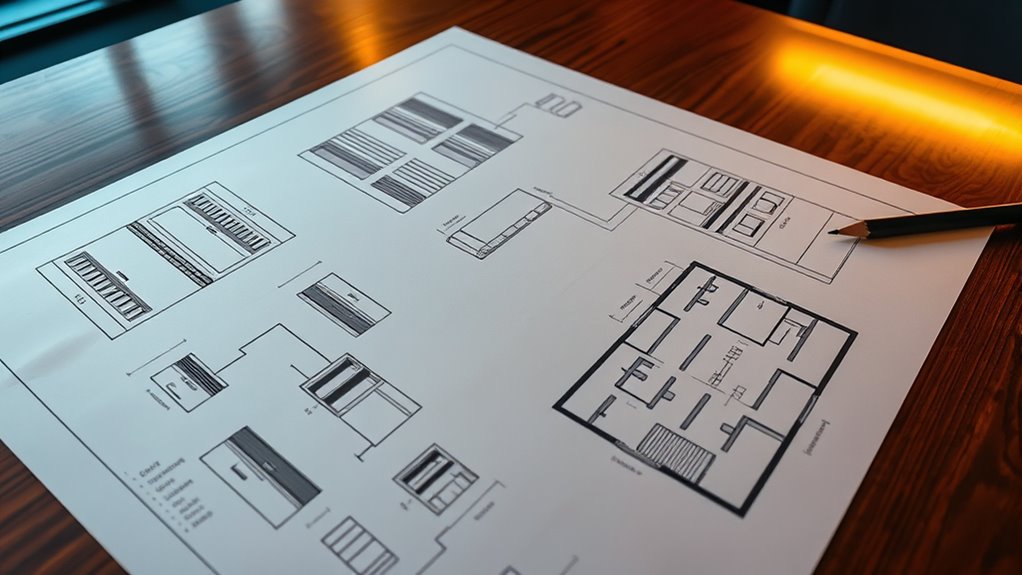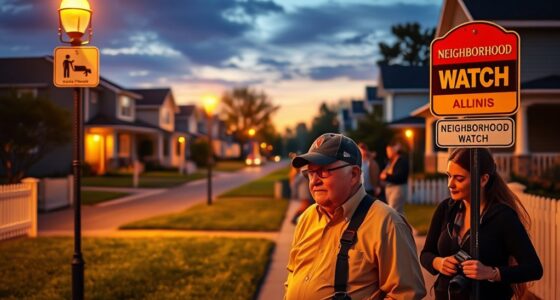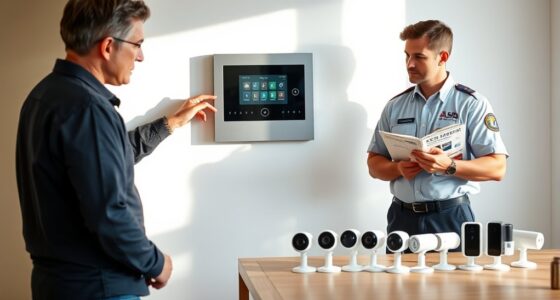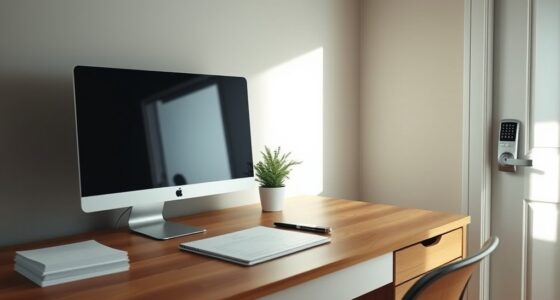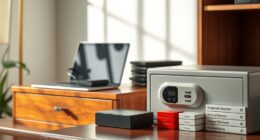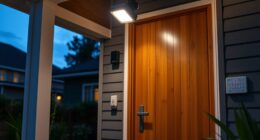To design a hidden safe room for ultimate safety, choose discreet locations like closets or basements and use clever concealment methods such as bookshelves or false walls. Reinforce doors with high-security locks and strengthen walls against forced entry. Integrate discreet lighting, ventilation, and insulation for comfort and privacy. Keep the design simple and blend seamlessly into your home’s décor, with security features hidden from plain sight. Discover how to optimize your safe room’s security and concealment strategies as you explore further.
Key Takeaways
- Select discreet, concealed locations like closets or basements that blend with existing home decor.
- Reinforce entry points with high-security locks and subtle hardware to maintain concealment.
- Use sturdy, soundproof materials and discreet ventilation for privacy and environmental control.
- Incorporate security systems like cameras and sensors outside the room for deterrence.
- Ensure compliance with local building codes while maintaining a simple, unassuming design.

Creating a hidden safe room is an essential step in enhancing your home’s security and ensuring peace of mind. When planning this space, you need to focus on effective security measures and concealment techniques that make it virtually undetectable to intruders. The goal is to create a secure haven that blends seamlessly into your home’s design while providing maximum protection. Start by choosing a strategic location—preferably a closet, basement, or a rarely used room—that doesn’t draw attention. This reduces the chances of someone stumbling upon it during an intrusion. Once the location is decided, consider how the entry will be concealed; a common approach is to use a bookshelf, a false wall, or a movable panel that looks like part of the decor. These concealment techniques are crucial in maintaining the room’s hidden status, so it’s best to keep the access point as inconspicuous as possible.
Choose a discreet location and conceal the entrance to keep your safe room hidden from intruders.
When designing the entryway, prioritize security measures that prevent unauthorized access. Reinforce the door with solid material, such as steel or high-quality wood, and install a strong lock system—preferably a biometric or keypad lock for added security. Avoid obvious lock hardware that could alert intruders to the presence of a safe room. Instead, opt for discreet mechanisms that only you can operate. Additionally, reinforce the walls with sturdy materials to withstand forced entry, and consider installing security cameras or alarm sensors outside the entrance to monitor any suspicious activity. These measures act as a deterrent and give you early warning if someone attempts to locate or access your safe room.
Lighting also plays a key role in the overall security design. Use concealed lighting fixtures that can be remotely controlled or triggered by motion sensors, illuminating the interior only when necessary. This prevents the room from appearing empty or suspicious when it’s not in use. Ventilation is another critical aspect—ensure you have a discreet, secure airflow system that maintains fresh air without compromising concealment. Proper insulation and soundproofing can enhance privacy and make it less likely for anyone to hear what’s happening inside. Incorporating local regulations and building codes into the design ensures your safe room remains compliant and legally sound.
Finally, keep your design simple and unassuming to avoid drawing attention. The true power of a hidden safe room lies in its ability to stay unnoticed until needed. By carefully integrating security measures with clever concealment techniques, you create a secure sanctuary that’s both functional and discreet. Remember, the less obvious it is, the safer you’ll be. When executed correctly, your hidden safe room becomes a vital part of your overall security plan, providing peace of mind no matter what threats you face.
Frequently Asked Questions
What Legal Restrictions Exist for Building Hidden Rooms?
You need to check local privacy laws and building permit requirements before constructing a hidden room. Some areas might restrict concealed spaces due to safety or zoning regulations, so obtaining the proper permits is vital. You should also verify your design doesn’t violate fire safety codes or building standards. Consulting with local authorities or a professional builder helps you stay compliant and avoid legal issues when creating your hidden safe room.
How Much Does It Cost to Construct a Hidden Safe Room?
You’ll probably find that constructing a hidden safe room costs more than you’d expect—irony at its finest. The cost estimation varies widely depending on size, materials, and security features, but generally, you should budget anywhere from $10,000 to over $50,000. Proper budget planning helps you manage expenses, ensuring you don’t overspend while still achieving ultimate safety. Remember, quality security doesn’t come cheap, but peace of mind is priceless.
Can a Hidden Safe Room Be Equipped With Ventilation?
Yes, a hidden safe room can be equipped with ventilation systems that guarantee proper air circulation. You should install discreet vents or ductwork to maintain fresh air intake and exhaust without revealing the room’s location. By doing so, you keep the space safe and comfortable, preventing stale air buildup while maintaining the room’s concealment. Proper ventilation is essential for long-term safety and peace of mind during emergencies.
What Are the Best Locations Within a Home for Hidden Rooms?
You should place your hidden rooms where they blend seamlessly, like behind a bookshelf, under stairs, or inside closets. These locations allow for discreet secret door mechanisms and concealed entry points that remain unnoticed. By choosing spots near common areas or bedrooms, you guarantee easy access while maintaining privacy. This placement maximizes safety, keeps the safe room hidden, and provides peace of mind when you need it most.
How Do I Ensure My Hidden Room Is Fireproof?
To guarantee your hidden room is fireproof, use fire-resistant materials like concrete, steel, or specialized drywall. Install a sprinkler system designed for concealed spaces to quickly suppress fires, and add smoke detectors for early alerts. Make sure all door and vent openings are sealed with fireproof barriers. Regularly maintain these safety features, and consider consulting a fire safety expert to optimize your hidden room’s resilience against fire hazards.
Conclusion
By following these steps, you’ll create a hidden safe room so secure that even a team of professional burglars would give up in frustration. It’ll be like having your own personal fortress, invisible to the world, where you can hide from anything—from natural disasters to alien invasions! With your secret haven, you’re not just safe; you’re practically untouchable. Get started now, and turn your home into the ultimate escape-proof fortress the world has never seen!
